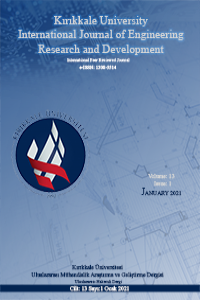Abstract
Turkish Building Seismic Code (TBSC), which was published in 2018 and became effective in 2019 prescribes a two-stage loading method for designing of a building with a rigid podium. In the first loading stage, the rigid podium is modeled as a massless structure and only mass of the superstructure is considered in the modal response spectrum analysis. The seismic design forces of the superstructure are computed using this model with the appropriate response modification coefficient and the overstrength factor. In the second loading stage, the superstructure is modeled as a massless system and only mass of the rigid podium is considered in the modal response spectrum analysis. The seismic design forces of the rigid podium are computed using this second model with the appropriate response modification coefficient and the overstrength factor. In addition, the seismic forces computed for the superstructure are superposed with those computed for rigid podium. Due to the use of separate building models for the analyses and superposition need, this process is relatively cumbersome, complex and prone to errors. In this study, based on the structural analysis results, some considerations and recommendations are presented on the modeling and design of buildings with a rigid podium.
Keywords
Rigid Podium Turkish Building Seismic Code 2018 Seismic Force Reduction Factor Nonlinear Response History Analysis Response Spectrum Analysis Tall Buildings
References
- CSI ETABS (2016). Extended 3D analysis of building systems, Nonlinear V. 16. Computers and Structures, Inc., Berkeley, CA.
- DBYBHY – Deprem Bölgelerinde Yapılacak Binalar Hakkında Yönetmelik (2007). Afet ve Acil Durum Yönetimi Başkanlığı, Türkiye Cumhuriyeti İçişleri Bakanlığı, Ankara.
- Jeong, S. Y., Kang, T. H. K., Yoon, J. K., Klemencic, R. (2020). Seismic performance evaluation of a tall building: Practical modeling of surrounding basement structures, Journal of Building Engineering, Volume 31, https://doi.org/10.1016/j.jobe.2020.101420.
- Naeim, F., Tileylioglu, S., Alimoradi, A., Stewart, J. P. (2008). Impact of foundation modeling on the accuracy of response history analysis of a tall building, SMIP08 Seminar Proceedings, California.
- Öztürk, B. (2006). Dynamic Analysis and The Resulting Nonlinear Response of Building Structures Located in Seismically Active Regions in Turkey, Paper No. 078, 4th International Conference on Earthquake Engineering, Taipei, Taiwan.
- TBDY – Türkiye Bina Deprem Yönetmeliği (2018). Afet ve Acil Durum Yönetimi Başkanlığı, Türkiye Cumhuriyeti İçişleri Bakanlığı, Ankara.
- TS 500 (2000). Betonarme Yapıların Tasarım ve Yapım Kuralları, Türk Standartları Enstitüsü, Ankara.
- Tura, C., Orakcal, K. (2019). Earthquake response analysis of multiple towers on a common podium: a representative case study, Tek. Dergi 30 (6) (2019) 9647–9673.
- Zhou, Y., Chen, P., Wang, C., Zhang, L., Lu, L. (2018). Seismic performance evaluation of tall, multitower reinforced concrete buildings with large bottom podiums, Struct. Concr. 19 (6) (2018) 1591–1607.
Abstract
2018’de yayınlanan ve 2019’da yürürlüğe giren Türkiye Bina Deprem Yönetmeliği (TBDY) rijit bodrumlu binaların tasarımında iki aşamalı yüklemeye dayanan bir yöntemi zorunlu kılmaktadır. Birinci aşama yüklemesinde rijit bodrum kütlesiz olarak, üstyapı kendi kütlesiyle modellenir. Böylelikle mod birleştirme yöntemiyle deprem analizinde sadece üstyapının kütlesi dikkate alınır. Üstyapının tasarımında kullanılacak deprem kuvvetleri, üstyapının yapısal özelliklerine uygun olarak seçilen deprem yükü azaltma katsayılarıyla bu modelden elde edilir. İkinci aşama yüklemesinde üstyapı kütlesiz olarak, rijit bodrum kendi kütlesiyle modellenir ve böylelikle deprem analizinde sadece rijit bodrumun kütlesi dikkate alınır. Rijit bodrumun tasarımında kullanılacak deprem kuvvetleri, kendisinin yapısal özelliklerine uygun olarak seçilen deprem yükü azaltma katsayılarıyla bu ikinci modelden elde edilir. Ayrıca, bu şekilde belirlenen rijit bodrum deprem kuvvetlerine üstyapıdan aktarılan düşey ve yatay kuvvetler de eklenir. Üstyapı ve rijit bodrumun deprem hesabında farklı analiz modellerinin kullanılması ve bodrum katların tasarımında bu kuvvetlerin birleştirilmesi belli ölçüde zaman alıcı, karmaşık ve hataya müsait bir süreçtir. Bu çalışmada sayısal analiz sonuçlarına dayalı olarak, rijit bodrumlu binaların modelleme ve tasarımına yönelik bazı değerlendirmeler ve öneriler sunulmuştur.
Keywords
Rijit Bodrumlu Binalar Türkiye Bina Deprem Yönetmeliği 2018 Deprem Yükü Azaltma Katsayısı Zaman Tanım Alanında Doğrusal Olmayan Analiz Mod Birleştirme Analizi Yüksek Yapılar
References
- CSI ETABS (2016). Extended 3D analysis of building systems, Nonlinear V. 16. Computers and Structures, Inc., Berkeley, CA.
- DBYBHY – Deprem Bölgelerinde Yapılacak Binalar Hakkında Yönetmelik (2007). Afet ve Acil Durum Yönetimi Başkanlığı, Türkiye Cumhuriyeti İçişleri Bakanlığı, Ankara.
- Jeong, S. Y., Kang, T. H. K., Yoon, J. K., Klemencic, R. (2020). Seismic performance evaluation of a tall building: Practical modeling of surrounding basement structures, Journal of Building Engineering, Volume 31, https://doi.org/10.1016/j.jobe.2020.101420.
- Naeim, F., Tileylioglu, S., Alimoradi, A., Stewart, J. P. (2008). Impact of foundation modeling on the accuracy of response history analysis of a tall building, SMIP08 Seminar Proceedings, California.
- Öztürk, B. (2006). Dynamic Analysis and The Resulting Nonlinear Response of Building Structures Located in Seismically Active Regions in Turkey, Paper No. 078, 4th International Conference on Earthquake Engineering, Taipei, Taiwan.
- TBDY – Türkiye Bina Deprem Yönetmeliği (2018). Afet ve Acil Durum Yönetimi Başkanlığı, Türkiye Cumhuriyeti İçişleri Bakanlığı, Ankara.
- TS 500 (2000). Betonarme Yapıların Tasarım ve Yapım Kuralları, Türk Standartları Enstitüsü, Ankara.
- Tura, C., Orakcal, K. (2019). Earthquake response analysis of multiple towers on a common podium: a representative case study, Tek. Dergi 30 (6) (2019) 9647–9673.
- Zhou, Y., Chen, P., Wang, C., Zhang, L., Lu, L. (2018). Seismic performance evaluation of tall, multitower reinforced concrete buildings with large bottom podiums, Struct. Concr. 19 (6) (2018) 1591–1607.
Details
| Primary Language | Turkish |
|---|---|
| Subjects | Civil Engineering |
| Journal Section | Articles |
| Authors | |
| Publication Date | January 18, 2021 |
| Submission Date | October 7, 2020 |
| Published in Issue | Year 2021 Volume: 13 Issue: 1 |
Cited By
BODRUM KATLARDA RİJİT BODRUM PERDE TASARIMININ YAPI DAVRANIŞI ÜZERİNDEKİ ETKİSİ
Kahramanmaraş Sütçü İmam Üniversitesi Mühendislik Bilimleri Dergisi
https://doi.org/10.17780/ksujes.1111218
Kırıkkale University, Faculty of Engineering and Natural Science, 71450 Yahşihan / Kırıkkale, Türkiye.
ijerad@kku.edu.tr

